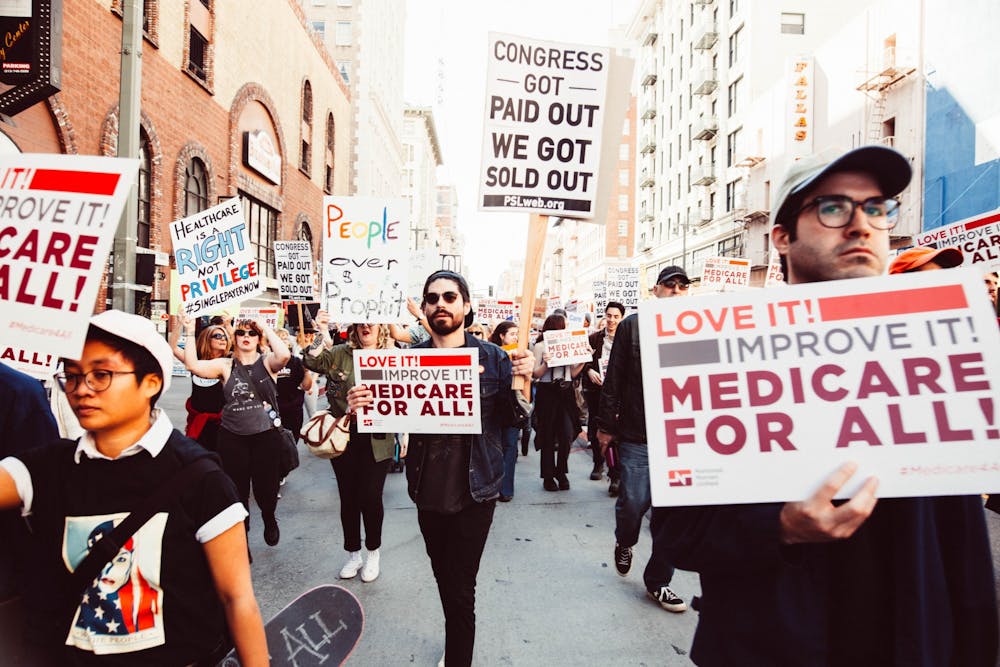All conversations about Medicare for All eventually lead back to one question: How are we going to pay for this? Before delving into voices from Hopkins and our greater Baltimore community, I wanted to put the matter to rest once and for all.
There’s no getting around the fact that Medicare for All will be an expensive endeavor. A study from the Urban Institute found that a single-payer medical insurance health care system would increase federal spending by $34.0 trillion dollars over 10 years, though household and state spending would decline significantly.
Federal spending aside, another good estimate of the cost of the health care is the National Health Expenditure (NHE). This number includes spending by states, government, private citizens and businesses.
Switching to a Medicare for All (M4A) plan, according to Business Insider, would make national health spending $2 trillion lower from 2022 to 2031. However, I want to emphasize that while there are many statistics floating around, both positive and negative, we may not be able to accurately predict the numbers, savings or cost until more specifics are revealed.
What we do know is this: according to a study published in The Lancet, 37 million Americans do not have health insurance, and 41 million Americans are currently under-insured; their plans do not provide full coverage.
Medicare for All will not just provide full health care for everyone. It would most likely also expand health care to include dental, vision and hearing, which many plans do not currently include. This extension of health care will be a hefty financial responsibility, but I believe our country is well equipped to handle this expansion.
There are a number of ways our country could afford to provide universal health care for our residents.
Let’s start with the one that turns most people off the universal health care plan altogether: taxes. Taxes on all income brackets will most likely increase under a universal health-care system, with the wealthiest paying the most under a progressive tax rate.
However, copays, deductibles and payments for health care would be nonexistent under a M4A plan. Again, studies diverge on whether Americans would overall be paying less or the same on health care with a tax increase, but even if the price stays the same, around 70 to 80 million more Americans (based on earlier numbers of the uninsured or underinsured) would have good health insurance. The trade-off personally seems worth it.
However, taxes are not the only way we can pay for Medicare for All, and some of these other methods may mitigate the tax burden. Right now, drug prices in America are exorbitantly high and health insurance companies profit in the billions.
Eliminating private insurance would eliminate one of the middlemen in a system that often bankrupts many Americans. High pharmaceutical prices are especially nefarious as the research needed to develop and mass produce the drugs is funded by taxpayers, who must then pay exorbitant prices for the same products they helped finance.
While insurance companies claim the large profit margins go into research and development, much of the extra money also ends up going into advertising and sales. That’s not to say the cost to get a drug approved and through the Food and Drug Administration is cheap, but it may not be as much as pharmaceutical companies claim it is.
A Journal of the American Medical Association study found that the median cost of developing one cancer drug is $648.0 million, whereas the median revenue was $1.6584 billion. Cancer drugs rarely cost over a billion to produce even though the profits often fall that way, as cancer cures are often on the more profitable end of the spectrum.
“The price of medicines is not determined by their research costs. Instead, it is determined by their value in preventing and treating disease,” former Merck CEO Raymond Gilmartin said in an interview with The Wall Street Journal.
Another huge issue with drug prices is evergreening. Pharmaceutical companies want to remain the exclusive patent owners of profitable drugs, so when the patent nears expiry date, they make a small, usually insignificant chemical change in the medicinal compound and renew the patent to keep their monopoly.
A united health-care system where everybody is part of one plan would give the government major bargaining power with pharmaceutical companies to negotiate lower prices. This is because the government is the corporation that issues patents in the first place.
If pharmaceutical companies refuse to be reasonable in their pricing, the government could open the market again for the drug. This is the most effective way that prices would reduce.
Other than increasing taxes and lowering prices on drugs and health service, our government could also consider reallocating current budget priorities, such as reducing military spending to increase health spending. Additionally, our system is a bureaucratic nightmare with all the processing and paperwork that needs to happen. A study in 2017 in the Annals of Internal Medicine found that single-payer reform could save about $503 billion on bureaucracy alone.
While paying for Medicare for All should be of top concern, our current health-care system is in many ways unaffordable for many Americans. Switching to a different system may bear unexpected expenditures but also unexpected savings. The risk is a worthwhile one as it would better millions of lives if successful.

















